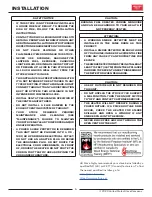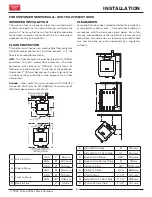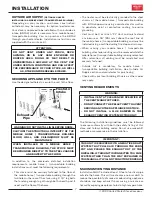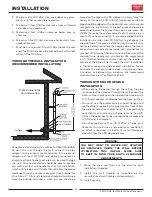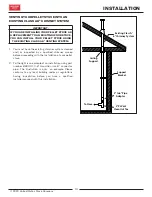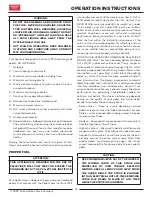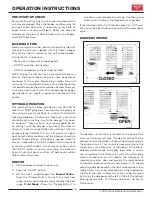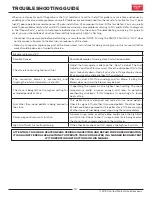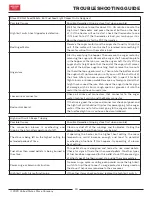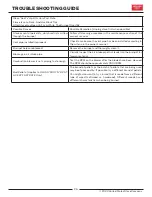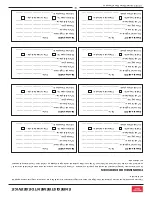
© 2023 United States Stove Company
17
container until all embers have been thoroughly cooled.
The container shall not be used for other trash or waste
disposal. If combined with combustible substances,
ashes and embers may ignite. Ash removal is as follows:
1. Let the fire burn out and allow the unit to cool to room
temperature.
2. Make sure the pellet stove is at room temperature
before touching. Open the door, remove the burn pot
and empty it into a metal container.
3. Vacuum ashes from the firebox. BE SURE THAT
ASHES ARE COOL TO THE TOUCH BEFORE
VACUUMING. Some vacuum cleaners may leak ash
into the room. Your vacuum cleaner should have a
special filter or bag to eliminate leakage.
4. Reinstall the burn pot.
SMOKE & CO MONITORS
Burning wood naturally produces smoke and carbon
monoxide(CO) emissions. CO is a poisonous gas when
exposed to elevated concentrations for extended
periods of time. While the modern combustion systems
in heaters drastically reduce the amount of CO emitted
out the chimney, exposure to the gases in closed or
confined areas can be dangerous. Make sure you stove
gaskets and chimney joints are in good working order
and sealing properly to ensure unintended exposure. It is
recommended that you use both smoke and CO monitors
in areas having the potential to generate CO.
CHECK & CLEAN THE HOPPER
Check the hopper periodically to determine if there is any
sawdust (fines) that is building up in the feed system or
pellets that are sticking to the hopper surface. Clean as
needed.
DOOR & GLASS GASKETS
Inspect the main door and glass window gaskets
periodically. The main door may need to be removed to
have frayed, broken, or compacted gaskets replaced
by your authorized dealer. This unit’s door uses a 3/4”
diameter rope gasket.
BLOWER MOTORS
Clean the air holes on the motors of both the exhaust
and distribution blowers annually. Remove the exhaust
blower from the exhaust duct and clean out the internal
fan blades as part of your fall start-up. If you have indoor
pets your power motors should be inspected monthly to
make sure they are free of animal hair build up. Animal
hair build up in blowers can result in poor performance or
unforeseen safety hazards.
PAINTED SURFACES
Painted surfaces may be wiped down with a damp cloth.
If scratches appear, or you wish to renew your paint,
contact your authorized dealer to obtain a can of suitable
high-temperature paint.
FALL START UP
Prior to starting the first fire of the heating season,
check the outside area around the exhaust and air intake
systems for obstructions. Clean and remove any fly ash
from the exhaust venting system. Clean any screens on
the exhaust system and on the outside air intake pipe.
Turn all of the controls on and make sure that they are
working properly. This is also a good time to give the
entire stove a good cleaning throughout.
SPRING SHUTDOWN
After the last burn in the spring, remove any remaining
pellets from the hopper and the auger feed system. Scoop
out the pellets and then run the auger until the hopper
is empty and pellets stop flowing (this can be done by
pressing the “ON” button with the viewing door open).
Vacuum out the hopper. Thoroughly clean the burn pot,
and firebox. It may be desirable to spray the inside of the
cleaned hopper with an aerosol silicone spray if your stove
is in a high humidity area. The exhaust system should be
thoroughly cleaned.
MAINTENANCE SCHEDULE
Use the following as a guide under average use conditions.
Gaskets around door and door glass should be inspected
and repaired or replaced when necessary.
Daily
Weekly Monthly or
as needed
Burn Pot
Stirred
Empty
Combustion
Chamber
Brushed
Ashes
Check
Empty
Interior Chambers
Vacuumed
Combustion
Blower Blades
Vacuumed
/ Brushed
Convection Blower
Impeller
Vacuumed
/ Brushed
Vent System
Cleaned
Gaskets
Inspected
Glass
Wiped Cleaned
Hopper (end of
season)
Empty &
Vacuumed
MAINTENANCE



